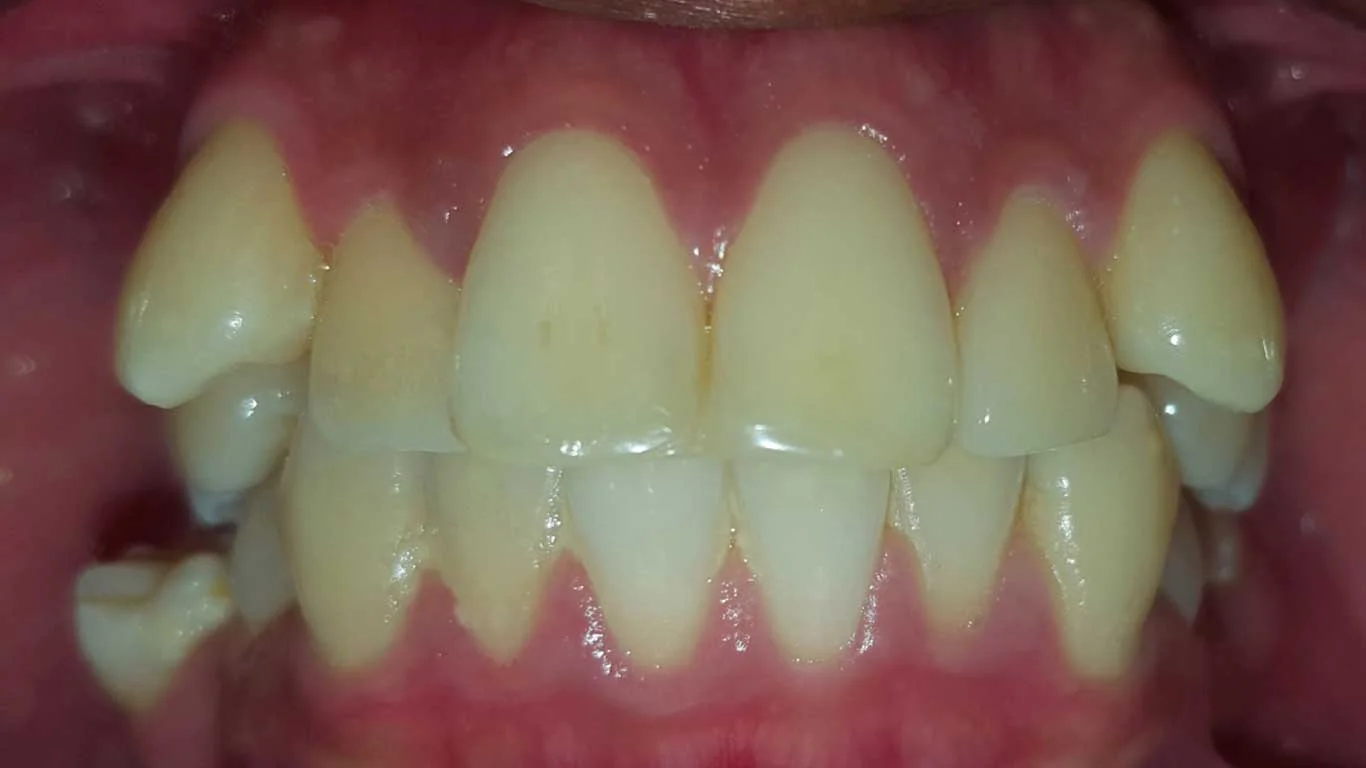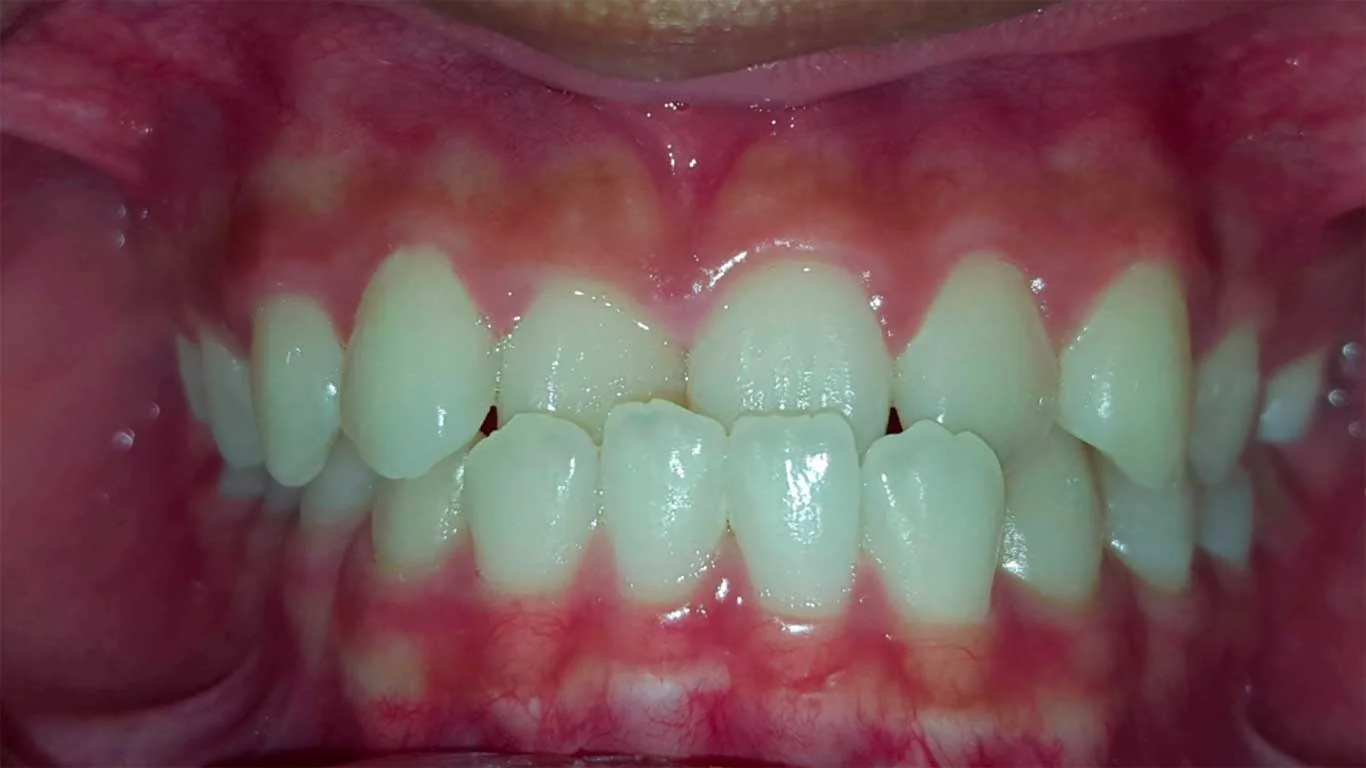Malocclusion
Malocclusion of teeth is a term used to describe a misalignment of the teeth and/or the jaws. This condition can cause a range of issues, including difficulty chewing and speaking, as well as cosmetic concerns.
Teeth malocclusion can occur due to a variety of factors, such as genetics, childhood habits, and dental problems or traumas. According to the World Health Organization, malocclusion is a prevalent issue in children and adolescents, affecting anywhere from 39% to 93% of individuals in this age group. Crowding and spacing are the most common types of malocclusions, with a prevalence of up to 84% and around 60%, respectively.
While malocclusion can lead to dental issues such as tooth decay and gum disease, it can be treated through orthodontic options such as traditional braces and clear aligners. Identifying and treating malocclusion early can improve oral health and boost confidence in one's smile.
In this guide, we'll walk through everything you need to know about this issue.
Malocclusion- What is It?
Dental malocclusion is a misalignment issue, causing poor positioning of the teeth when the jaws are closed. A normal occlusion (bite) is when the jaw bones are in the correct position in relation to the teeth. Meaning, your upper and lower molar relationship is aligned and the upper teeth slightly overlap the lower teeth when the jaw is closed. When this is not the case, it affects one’s ability to perform necessary functions such as chewing and speaking.
Malocclusion can refer to a number of different problems including:
- Crowding: Crowding occurs when there is too little room for the teeth, causing what many refer to as crooked teeth.
- Spacing: Occurs when there is too much room for teeth. Allowing teeth to grow or drift out of place, causing gaps between teeth.
- Overbite: Overbite occurs when the upper front teeth reach too far down, covering the lower teeth.
- Underbite: Underbite occurs when the lower teeth protrude farther forward than the upper teeth.
- Open Bite: Open bite occurs when the upper and lower teeth do not overlap, causing an open space between.
- Crossbite: Crossbite occurs when an upper tooth or teeth it into the wrong side of the lower teeth.
Read More: Crooked Canine Teeth

Causes
Typically, teeth malocclusion problems are inherited, meaning there is no way to prevent the cause. However, there are some factors and conditions that can alter the shape or position of the jaw, resulting in malocclusion.
- Cleft lip and/or palate
- Injuries affecting the alignment of the jaw(s)
- Abnormally shaped or impacted teeth
- Thumb sucking in early childhood
- Use of pacifier or bottle after the age of 3
Although for most cases you cannot prevent malocclusion, avoiding or controlling some of habits listed above can prevent the severity of the issue.
Symptoms:
The symptoms of these conditions can vary depending on the type of malocclusion. Some symptoms can be more severe than others. The following are indications of the malocclusion problems listed above.
- Headaches
- Difficulty or discomfort when chewing and/or biting
- Common biting or lips and cheeks
- Altered appearance of the face
- Mouth breathing habit
- Speech problems
Read More: Orthodontics Before and After

Diagnosing & Treatment:
Typically, a general dentist is the first to determine if a patient has misalignment issues. The dentist will pull the patient’s cheeks outward, and ask for them to bite down. Allowing the dentist to see the positioning of one’s teeth when their jaws are closed. Any issues addressed will then be referred to an orthodontist for further diagnosis. Diagnostic procedures such as head, teeth and skull x-rays, as well as orthodontic records will help diagnose the malocclusion.
When there is a misalignment of the teeth and jaw, malocclusion is diagnosed. Malocclusion is then categorized into 3 classes depending on the type and severity of the misalignment in one’s mouth.
Types of Malocclusions
Here is the list of malocclusion class:
Class I
Malocclusion Class I refers to a dental condition where the bite is generally aligned, with the upper and lower teeth fitting together correctly. However, there may be slight misalignments or crowding of the teeth, which can lead to cosmetic or functional issues. It's considered the least severe form of malocclusion.
Class II
Class II malocclusion, also known as "overbite," occurs when the upper teeth significantly overlap the lower teeth. In this dental malocclusion, the upper jaw may protrude, causing misalignment that affects both function and appearance. It can lead to difficulties with biting, chewing, and speaking.

Class III
Class III malocclusion, or "underbite," occurs when the lower teeth overlap the upper teeth, with the lower jaw protruding beyond the upper jaw. This dental malocclusion can cause difficulty in biting, chewing, and speaking, and may lead to an unbalanced facial appearance. It is typically more severe than Class I and Class II malocclusions.
Different Treatments for Malocclusion of Teeth
There are several treatments available for malocclusion of teeth, depending on the severity and type of misalignment:
Braces: Traditional metal or ceramic braces are the most common treatment for correcting malocclusion. They use brackets, wires, and rubber bands to gradually move teeth into proper alignment.
Invisalign: A clear, removable aligner system that gradually shifts teeth into place. It's a less noticeable option compared to traditional braces and is often used for mild to moderate cases.
Retainers: After braces or Invisalign treatment, retainers help maintain the new position of the teeth and prevent them from shifting back.
Palatal Expanders: These devices are used to widen the upper jaw in cases of crossbite or narrow arches. They are often used in growing children.
Tooth Extraction: In cases where overcrowding is present, a dentist may recommend removing one or more teeth to create space and improve alignment.
Surgical Treatment: For severe malocclusions that can’t be corrected with braces alone, jaw surgery (orthognathic surgery) may be necessary to realign the jaws and improve bite function.
Functional Appliances: These are devices designed to modify the position of the jaws, especially in growing children, to correct jaw discrepancies and improve bite.
Treatment plans are customized based on individual needs, age, and the type of malocclusion present.
Read More: Post Braces Retainers
Jaw Malocclusion
Jaw malocclusion refers to misalignment of the upper and lower jaws, affecting how teeth fit together. It can be classified into three main types:
- Class I, where the bite is generally normal but teeth may be slightly misaligned;
- Class II (overbite), where the upper jaw protrudes over the lower jaw;
- and Class III (underbite), where the lower jaw protrudes beyond the upper jaw.
Malocclusion can be caused by genetics, thumb sucking, trauma, or abnormalities in tooth development.
Symptoms of jaw malocclusion may include difficulty chewing, biting, or speaking, along with jaw pain, teeth grinding, and sleep apnea. Treatment options range from braces and Invisalign to more advanced interventions like functional appliances for jaw correction or orthognathic surgery for severe cases. Retainers are often used post-treatment to maintain proper alignment.
Jaw malocclusion not only affects the functionality of the teeth but also can impact facial aesthetics, often causing an unbalanced appearance. Misaligned jaws can result in protruding or recessed chins, uneven cheekbones, and asymmetric features, which may lead to self-esteem issues. These aesthetic concerns can be particularly significant in adolescents and adults who may feel self-conscious about their appearance.
The condition can also have a serious impact on oral health. Misalignment increases the risk of uneven wear on teeth, which can lead to fractures, cavities, and other dental problems. Additionally, malocclusion may contribute to temporomandibular joint (TMJ) disorders, causing pain and discomfort in the jaw, as well as difficulty opening or closing the mouth. The misalignment can also make it harder to clean certain areas of the mouth, increasing the likelihood of gum disease and tooth loss.
Psychologically, jaw malocclusion can affect an individual’s confidence and social interactions. People may feel anxious or avoid social situations due to concerns about their appearance or speech. Early intervention, particularly in children, can prevent the worsening of these issues by guiding jaw and teeth growth. This proactive treatment can often reduce the need for more invasive procedures, such as jaw surgery, later in life.
FAQs
If malocclusion is left untreated, it can lead to long-term dental problems such as tooth decay, gum disease, uneven wear, and TMJ disorders. Additionally, it may cause difficulties with biting, chewing, speaking, and can negatively affect facial appearance and self-esteem.
Yes, malocclusion can contribute to TMJ (temporomandibular joint) disorders. Misalignment of the jaws puts extra strain on the TMJ, leading to pain, clicking, or difficulty opening and closing the mouth. This can worsen over time if left untreated.
The most common cause of malocclusion is genetics. Inherited traits, such as the size and shape of the jaw or teeth, can lead to misalignments. Other factors, like thumb sucking during childhood, early loss of baby teeth, or trauma to the jaw, can also contribute to developing malocclusion.
No, malocclusion typically does not go away on its own. Without treatment, misalignments of the teeth and jaws usually persist or worsen over time. Early intervention with braces, aligners, or other dental treatments is often needed to correct the condition and prevent further complications.
Takeaway
Dental malocclusion refers to misalignment of the teeth and jaws, which can lead to issues like difficulty chewing, speaking, and cosmetic concerns. Common types of malocclusion of teeth include crowding, spacing, overbite, underbite, and crossbite. Causes range from genetics to childhood habits like thumb sucking. If untreated, malocclusion can result in tooth decay, gum disease, TMJ disorders, and affect facial aesthetics, leading to self-esteem issues.
At York Orthodontics, we offer a variety of treatments for correcting malocclusion, including braces, Invisalign, and retainers for more severe cases. Early diagnosis and intervention are crucial to improving oral health and restoring confidence in your smile.
